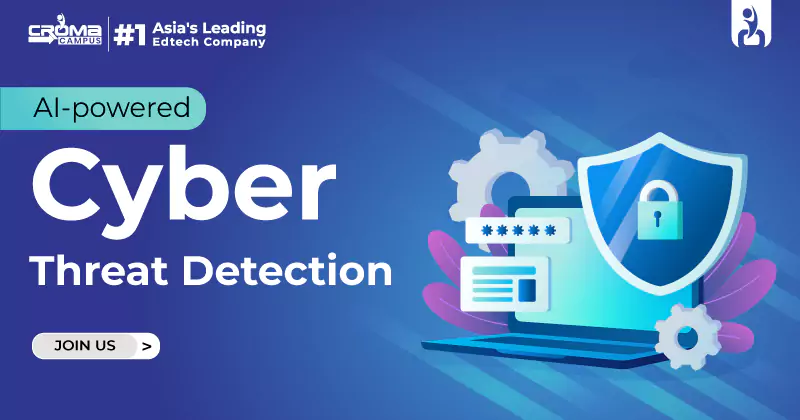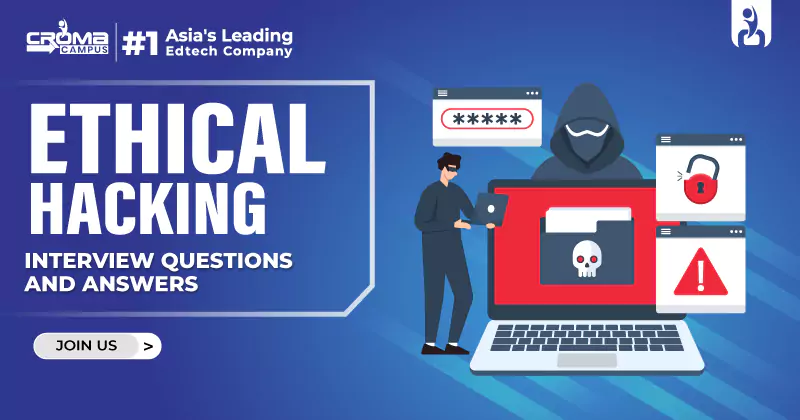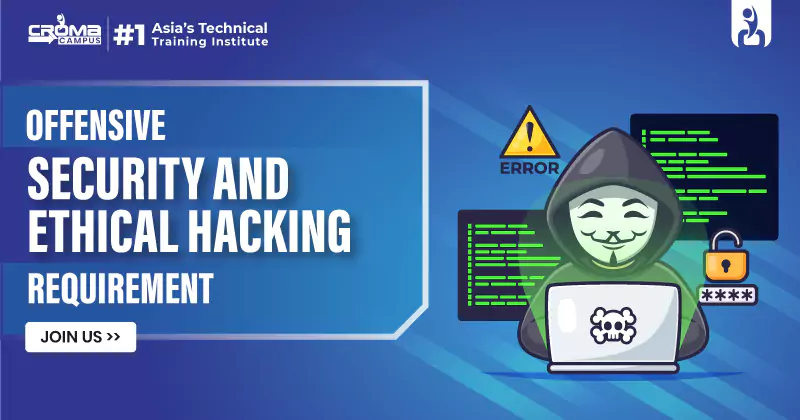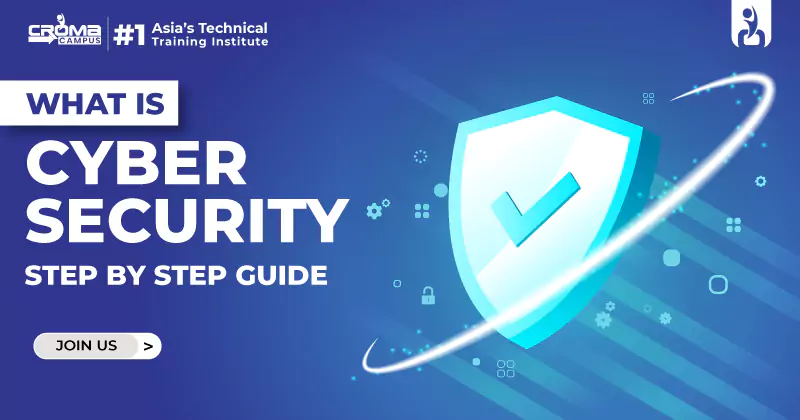What Is Cyber Security? Step By Step Guide
4.9 out of 5 based on 9574 votesLast updated on 31st Jul 2024 16.39K Views
- Bookmark

Cybersecurity protects digital data from threats. Learn basics like encryption, firewalls, and ethical hacking in a step-by-step guide.

Introduction
With cyber threats on the increase, individuals and businesses need to understand what cyber security is and how to protect themselves from potential attacks. In this step-by-step guide, we will break down the basics of cyber security and provide actionable tips for keeping your data safe. These attacks can come in many forms, including viruses, malware, phishing scams, ransomware, and more. The goal of cyber security is to prevent unauthorized access to data, theft of personal information, disruption of services, and other malicious activities. Also, why it is important to enroll in a Cyber Security Course.
Types of CyberSecurity
With cyber-attacks on the rise, it is important to understand the different types of cybersecurity measures that can help protect your personal information and sensitive data. We will explore the various types of cyber security and how they can safeguard against online threats. Try going through the top Cyber Security Interview Questions to ace the training.
Network Security
Network security is a crucial aspect of cyber security that focuses on protecting the integrity and confidentiality of data as it is transmitted across networks. This type of security involves implementing firewalls, intrusion detection systems, and virtual private networks (VPNs) to secure network traffic and prevent unauthorized access.
Endpoint Security
This type of security involves installing antivirus software, encrypting data, and implementing access controls to prevent malware infections and unauthorized access to sensitive information.
Cloud Security
With the increasing adoption of cloud services, cloud security has become essential in protecting data stored in the cloud. This type of security involves encrypting data, implementing access controls, and monitoring for unusual activity to prevent data breaches and unauthorized access to cloud resources.
Application Security
Application security focuses on securing software applications from threats and problems. This type of security involves conducting code reviews, implementing security testing, and regularly updating software to patch vulnerabilities and prevent cyber attacks.
Data Security
Data security involves protecting data from unauthorized access, disclosure, and alteration. This type of security involves encrypting data, implementing access controls, and regularly backing up data to prevent data loss and maintain data integrity.
IoT Security
IoT security has become a growing concern and it focuses on securing interconnected devices such as smart home devices and industrial sensors to prevent cyber attacks and data breaches.
Incident Response
Incident response is an essential aspect of cyber security that involves preparing for and responding to cyber security incidents. This type of security involves creating an incident response plan, conducting regular drills, and coordinating with stakeholders to minimize the impact of cyber attacks.
Why is Cyber Security Important?
Cybersecurity is important for several reasons. First and foremost, it helps protect our personal information from being stolen and misused. In an age where identity theft is rampant, keeping our data secure is essential to safeguarding our financial and personal well-being. Additionally, cyber security helps protect businesses from falling victim to data breaches that could result in significant financial losses and damage to their reputation. Both cybersecurity and the Cyber Security Course are very important.
Investing in cyber security measures can help reduce these risks and keep your data safe from malicious actors. By implementing strong passwords, firewalls, and encryption technologies, you can create a unique defense system against cyber attacks. In addition, regular software updates and security audits are essential to staying one step ahead of cybercriminals. Amongst all, the most asked Cyber Security Important Questions are how you can achieve your cyber security goals.
What Are Cyber Security Goals?
The CIA model plays an important role in ensuring the protection of sensitive information. The CIA model, which stands for Confidentiality, Integrity, and Availability, is a framework that helps organizations safeguard their data and systems from various threats. Let's delve into each aspect of the CIA model to understand its significance. It is significant to boost your career ahead with the Cyber Security Course in Delhi.
Confidentiality: Keeping Data Secure
Confidentiality is the pillar of the CIA model that focuses on keeping data secure and out of the hands of unauthorized users. This means that sensitive information should only be accessed by individuals who have the proper authorization to do so. Encryption plays a vital role in maintaining confidentiality by ensuring that data is only accessible to those who have the appropriate decryption keys.
Integrity: Ensuring Data Accuracy and Consistency
Integrity is another key component of the CIA model, focusing on maintaining the accuracy and consistency of data throughout its lifecycle. This involves implementing measures to prevent unauthorized modifications, deletions, or insertions that could compromise the integrity of the data. Data integrity checks, such as checksums and hashing algorithms, are commonly used to detect any unauthorized changes to data.
Availability: Keeping Systems Accessible at All Times
Availability is the third pillar of the CIA model, focusing on ensuring that systems and data are accessible to authorized users when needed. Downtime can have severe consequences for organizations, leading to financial losses and reputational damage. Therefore, it is essential to implement measures to maintain high availability and minimize downtime. You can learn from the Cyber Security Course in Delhi!
Types of Cyber Security Threats
Malware
Malware, short for malicious software, is a type of cyber security threat that is designed to damage or gain unauthorized access to a computer system. This includes viruses, worms, Trojans, and ransomware. Malware can be spread through infected email attachments, malicious websites, or even through software downloads.
- Viruses
Viruses are malicious programs that can replicate themselves and spread from one device to another. Once inside your device, viruses can corrupt your files, steal your data, and even take control of your device.
- Worms
Worms are similar to viruses but do not require user interaction to spread. Worms can cause network congestion, slow down your devices, and leave them vulnerable to other cyber threats.
- Trojans
Trojans, named after the infamous Trojan Horse, are deceptive programs that masquerade as legitimate software. Once you unknowingly download a trojan, it can create backdoors in your system, allowing cybercriminals to access your device remotely.
- Ransomware
Ransomware is a malware that encrypts your files and the file gets infected, you may find yourself locked out of your own data, unable to access your files unless you pay the ransom.
Phishing
Phishing is a type of cyber security threat where hackers attempt to trick individuals into providing sensitive information, such as passwords or credit card details. The message will often contain a sense of urgency or importance, prompting the recipient to take immediate action, such as clicking on a link or providing their information.
Man-in-the-Middle Attacks
In a man-in-the-middle attack, hackers intercept communication between two parties, such as a user and a website, without either party knowing. This allows the hacker to eavesdrop on sensitive information or manipulate the communication for their gain. Man-in-the-middle attacks are particularly dangerous when it comes to online banking or shopping.
Denial of Service (DoS) Attacks
A denial of service attack is when hackers flood a website or network with traffic, causing it to become overwhelmed and unavailable to legitimate users. This can result in financial losses for businesses or disrupt services for individuals. Distributed Denial of Service (DDoS) attacks, where multiple sources are used to overwhelm the target, are even more challenging to defend against.
SQL Injection
SQL injection is a type of cyber security threat where hackers inject malicious code into a website's database, allowing them to access and manipulate sensitive information. This can lead to data breaches, identity theft, or website defacement. Proper security measures and regular software updates can help prevent SQL injection attacks.
Social Engineering
Social engineering is a type of cyber security threat where hackers manipulate individuals into divulging sensitive information or performing actions that compromise security. Awareness training and strict security protocols are key to defending against social engineering attacks.
Also Read These Posts:
Become A Cyber Security Professional
Benefits Of Learning Cyber Security
Steps to Improve Cyber Security
Update Your Software Regularly: One of the easiest ways to protect your devices from cyber threats is to keep your software up to date. Software updates can address issues that hackers could exploit.
Use Strong Passwords: Create unique passwords for each of your accounts, and use a combination of letters, numbers, and special characters. Avoid using easily guessable passwords such as "123456" or "password."
Enable Two-Factor Authentication: Two-factor authentication adds an extra layer of security, such as a code sent to your phone or any other form of checking.
Be Cautious of Phishing Scams: Phishing emails are a common tactic used by cyber criminals to gain access to sensitive information. Be suspicious of emails asking for personal information or urging you to click on links.
Secure Your Network: Make sure your home or office network is secure by using firewalls, encryption, and monitoring tools to detect and prevent unauthorized access.
Backup Your Data: Regularly backup your important files to an external hard drive or cloud storage service. In the event of a cyber-attack, you will have a copy of your data that can be restored.
Latest Cyber Threats
Romance Scams:
Romance scams are a type of online fraud where cybercriminals manipulate individuals into forming romantic relationships to gain access to their personal and financial information. These scammers create fake profiles and build trust over time before asking for money or sensitive data. To protect yourself from romance scams, always be cautious when interacting with strangers online
Dridex Malware:
Dridex malware is a sophisticated banking trojan that targets Windows users to steal sensitive information such as login credentials, financial data, and personal information. This malware is often distributed through phishing emails that contain malicious attachments or links. To defend against Dridex malware, ensure your antivirus software is up-to-date, avoid clicking on suspicious links or attachments.
Emotet Malware:
Emotet malware is a notorious banking trojan that has been active since 2014. It spreads through malicious email attachments or links and can quickly infect an entire network. To protect from Emotet malware, train your employees to recognize phishing emails, implement email filtering solutions, and regularly update your software to patch vulnerabilities.
Conclusion
By following these simple steps, you can greatly reduce your risk of falling victim to a cyber attack. Remember, cyber security is an ongoing process that requires vigilance and attention to detail. Stay informed about the trending threats and best practices, and always prioritize the safety of your digital assets. The importance of cyber security cannot be emphasized enough. By implementing powerful security measures and staying vigilant against cyber threats, we can protect ourselves and our data from falling into the wrong hands.
Subscribe For Free Demo
Free Demo for Corporate & Online Trainings.
Your email address will not be published. Required fields are marked *






















 Master in Cloud Computing Training
Master in Cloud Computing Training